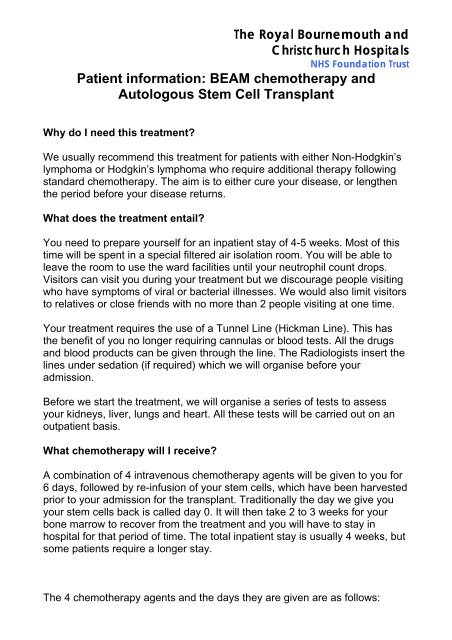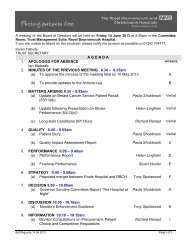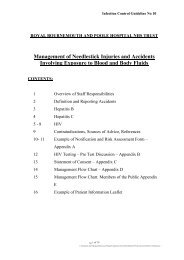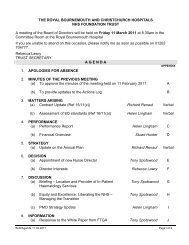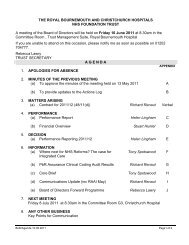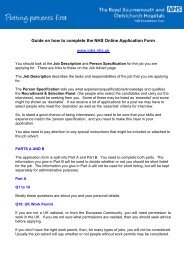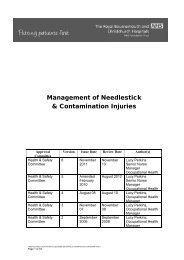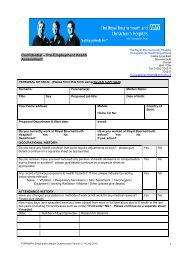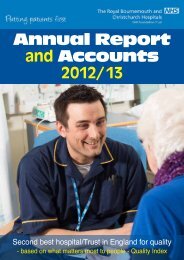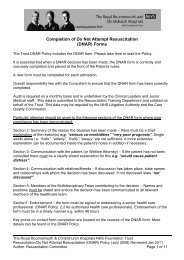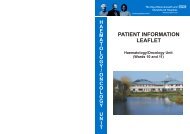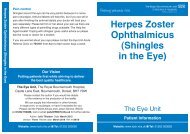BEAM chemotherapy and Autologous Stem Cell ... - Jigsaw Appeal
BEAM chemotherapy and Autologous Stem Cell ... - Jigsaw Appeal
BEAM chemotherapy and Autologous Stem Cell ... - Jigsaw Appeal
You also want an ePaper? Increase the reach of your titles
YUMPU automatically turns print PDFs into web optimized ePapers that Google loves.
The Royal Bournemouth <strong>and</strong>Christchurch HospitalsNHS Foundation TrustPatient information: <strong>BEAM</strong> <strong>chemotherapy</strong> <strong>and</strong><strong>Autologous</strong> <strong>Stem</strong> <strong>Cell</strong> TransplantWhy do I need this treatment?We usually recommend this treatment for patients with either Non-Hodgkin’slymphoma or Hodgkin’s lymphoma who require additional therapy followingst<strong>and</strong>ard <strong>chemotherapy</strong>. The aim is to either cure your disease, or lengthenthe period before your disease returns.What does the treatment entail?You need to prepare yourself for an inpatient stay of 4-5 weeks. Most of thistime will be spent in a special filtered air isolation room. You will be able toleave the room to use the ward facilities until your neutrophil count drops.Visitors can visit you during your treatment but we discourage people visitingwho have symptoms of viral or bacterial illnesses. We would also limit visitorsto relatives or close friends with no more than 2 people visiting at one time.Your treatment requires the use of a Tunnel Line (Hickman Line). This hasthe benefit of you no longer requiring cannulas or blood tests. All the drugs<strong>and</strong> blood products can be given through the line. The Radiologists insert thelines under sedation (if required) which we will organise before youradmission.Before we start the treatment, we will organise a series of tests to assessyour kidneys, liver, lungs <strong>and</strong> heart. All these tests will be carried out on anoutpatient basis.What <strong>chemotherapy</strong> will I receive?A combination of 4 intravenous <strong>chemotherapy</strong> agents will be given to you for6 days, followed by re-infusion of your stem cells, which have been harvestedprior to your admission for the transplant. Traditionally the day we give youyour stem cells back is called day 0. It will then take 2 to 3 weeks for yourbone marrow to recover from the treatment <strong>and</strong> you will have to stay inhospital for that period of time. The total inpatient stay is usually 4 weeks, butsome patients require a longer stay.The 4 <strong>chemotherapy</strong> agents <strong>and</strong> the days they are given are as follows:
BCNU (carmustine): day-6Etoposide: each day from day –5 to day –2Ara-C (cytarabine): each day from day –5 to day –2Melphalan: on day –1Day –6 Day-5 Day-4 Day-3 Day-2 Day-1 Day 0__[__________[__________[_________[_________[_________[___________[____BCNU Etoposide Etoposide Etoposide Etoposide Melphalan <strong>Stem</strong>Ara-C Ara-C Ara-C Ara-C cellsOn day -1, you will be given a large amount of fluid intravenously to aidexcretion of the melphalan by the kidneys. We will monitor the fluid you drink<strong>and</strong> the urine you pass accurately. It is important that you make a note of thedrinks you have <strong>and</strong> do not flush any of the urine down the toilet before wemeasure the volume of it!The stem cells will be given to you by a doctor or a nurse. It is exactly like ablood transfusion: the stem cells are thawed <strong>and</strong> re-infused through theHickman line. The number of bags will vary from one patient to the other. Thestem cells are suspended in a solution of DMSO. This smells <strong>and</strong> tastes likesweet corn <strong>and</strong> your breath may smell for 2 to 3 days after the re-infusion ofthe cells. The infusion can sometimes cause an allergic reaction <strong>and</strong> we willpre-medicate you prior to giving you the stem cells. It is not unusual to havepink urine after the stem cell infusion.What side-effects can I expect?Nausea:All of these <strong>chemotherapy</strong> agents can cause nausea <strong>and</strong> vomiting. We willgive you a combination of anti-sickness medications in the form of injections<strong>and</strong> tablets. Occasional patients are very sensitive <strong>and</strong> may require an antisicknesspump.Flushing:BCNU, which is given on day -6 can cause flushing <strong>and</strong> headaches. Thisusually improves once the infusion has finished. The headaches can last for afew hours after the infusion.Blood pressure:
Occasionally Etoposide can cause your blood pressure to fall. We will monitorthis carefully, however it is important that you tell us if you feel dizzy orunwell.Rash:Many of the drugs we give can cause a rash, it is important that you let usknow. Ara-C can particularly cause a rash <strong>and</strong> fever.Gastro-intestinal side-effects:The <strong>chemotherapy</strong> agents will affect the lining of your mouth, throat, stomach<strong>and</strong> bowel. This will tend to reduce your appetite <strong>and</strong> may give you diarrhoea.Virtually all patients will suffer with a severe sore throat (mucositis) <strong>and</strong>swallowing can be difficult. We suggest that you suck some ice/lolly popsduring the melphalan infusion, which we have found to reduce the soremouth. Both the mucositis <strong>and</strong> diarrhoea last about 7 to 10 days. We havemany ways of helping your symptoms including pain killers.Infections:The <strong>chemotherapy</strong> causes neutropenia, which increases the risk of infection.We will try to prevent this by giving you a prophylactic combination of:Antibiotic: ciprofloxacinAntiviral: aciclovirAntifungal: itraconazoleAlthough this may help, many patients will still experience fever <strong>and</strong> rigors(shakes). We treat this promptly with injections of antibiotics rather thantablets. Occasionally patients can have severe infections, which are lifethreatening.If this occurs, sometimes we have to monitor you on theintensive care unit until you are better.It is very common to have a line infection during the time of neutropenia. Theexit site may become red, or sometimes the skin over the line becomesinflamed. In this situation we may need to remove the line if it does notimprove with antibiotics.Blood products:Due to bone marrow suppression, you will become anaemic <strong>and</strong>thrombocytopaenic (low platelet count which increases the risk of bleeding).We will give you blood transfusions <strong>and</strong> platelet transfusions as required untilyour bone marrow recovers. You will require irradiated blood products for life<strong>and</strong> we will give you an information card concerning this.
Hair loss:The <strong>chemotherapy</strong> will make you lose your hair. This is temporary <strong>and</strong> we willdiscuss with you strategies to cope with this.Mortality:The transplant procedure carries a mortality risk, usually from infection orbleeding. In our unit this risk is less then 5%.Long term side effects:Immunosuppression:Even after your bone marrow recovers <strong>and</strong> your neutrophils are back to anormal level, your immunity will be low for a few months. During that periodyou will be seen regularly as an outpatient <strong>and</strong> you will need to be treatedpromptly if you develop a temperature. We will continue the antibioticprophylaxis <strong>and</strong> to prevent an infection called Pneumocystis CarniiPneumonia (PCP), you will require either nebulisers monthly or additionalantibiotics. This will usually be stopped after a period of 6 months once weare happy with your immunity status. Do not stop them yourself.Fertility:The <strong>chemotherapy</strong> drugs can cause infertility, although not always, so youmust continue to take precautions against pregnancy. Often patients havereceived prior <strong>chemotherapy</strong> <strong>and</strong> will have discussed fertility with their doctor.However, you may want to discuss this further prior to the transplant. For menwe can offer sperm storage. Options are more limited in women, so pleaseask if you would like to persue this further.Secondary cancer <strong>and</strong> leukaemia:You should be aware that there is a small risk that the <strong>chemotherapy</strong> agentscan cause secondary leukaemia <strong>and</strong> cancer at a later date. We would behappy to discuss this with you further if you wish.What happens when I go home?We will let you go home when your blood counts are safe <strong>and</strong> all your sideeffects have gone. This varies between patients <strong>and</strong> it is difficult to give youan accurate time frame prior to the transplant. You will have medications totake home. Follow up will be on ward 10, you must have an appointmentbefore leaving the ward. The frequency of follow up depends on your specificneeds, but in the first few weeks will be once or twice a week.


